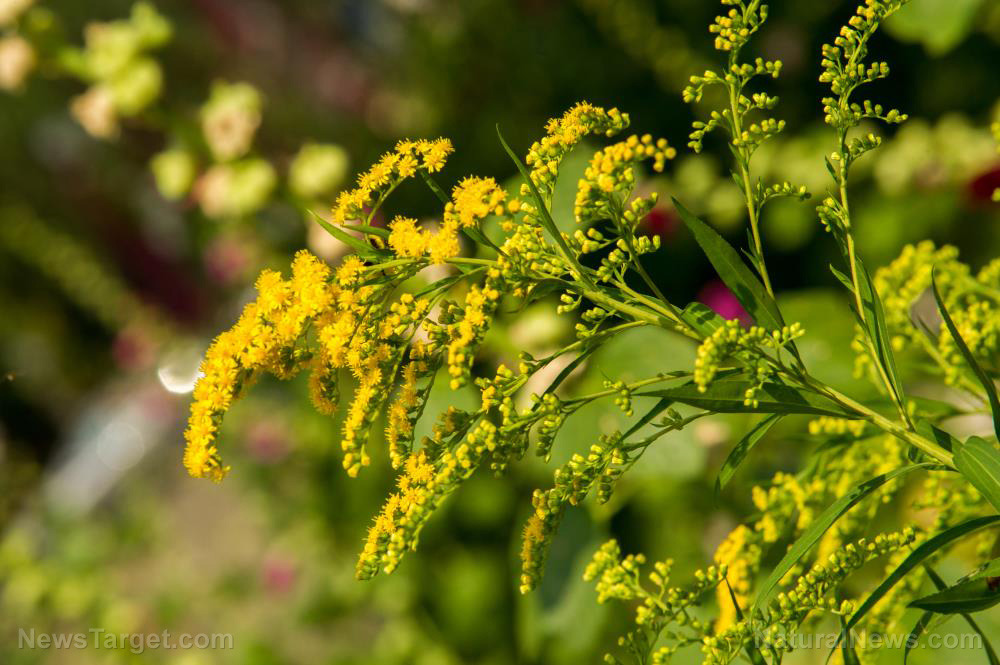
Goldenrod: Health benefits, medicinal uses and possible side effects
Goldenrod gets its common name from its small clusters of golden flowers, which bloom around August and September.
In nature, goldenrod can crossbreed with other plants, weeds or not. The U.S. alone is home to more than 130 species of goldenrod. This flowering plant can also be found in Europe and Africa as Solidago virgaurea. All of its species are edible but differ in taste. Some varieties possess a more bitter flavor, while others can be a lot more acidic.
Goldenrod is also quite a popular healing herb in traditional medicine thanks to its plethora of beneficial plant compounds including saponins, quercetin and kaempferol. (Related: Quercetin is one of the most potent natural antioxidants on the planet.)
Saponins, for example, enhance the body's immune system and protect it from pathogenic viruses, bacteria and fungi. Saponins also reduce cholesterol, decrease blood lipids and regulate blood sugar.
Flavonoids like kaempferol and quercetin, on the other hand, help protect against cellular damage caused by free radicals. Free radicals are unstable molecules that can damage deoxyribonucleic acid (DNA), which might trigger cancer cells and activate carcinogens.
Clinical trials on goldenrod also suggest that its antioxidant properties might be even greater than that of green tea leaves, one of the most antioxidant-rich edible plants available. Goldenrod is also known to have large doses of vitamin C.
As a medicinal plant, goldenrod has been used to treat a number of diseases and health conditions including diabetes, gout, hemorrhoids, internal bleeding, asthma, arthritis, oral inflammation, bacterial infections and fungal infections.
Although goldenrod is hailed for its inherent healing properties, it's important to note that goldenrod is also notorious for triggering seasonal allergies. Goldenrod tends to grow near ragweed, which is responsible for hay fever. Therefore, it might be best for people who are sensitive to pollen to avoid goldenrod.
Other possible side effects of goldenrod include heartburn, fluid retention and dehydration. Pregnant or nursing women should also consult a healthcare professional before using goldenrods to avoid other possible complications and side effects.
Tips on foraging for goldenrod
Goldenrod isn't difficult to spot if you know what to look for. Because these plants tend to grow near weeds, it's important to take note of the characteristics that distinguish goldenrod so you don't risk grabbing useless or poisonous weeds. Here are some tips for foraging for goldenrod:
- The flowers on goldenrod plants are about a quarter of an inch wide.
- The flowers also tend to grow in tight clusters around the top of the plant.
- Goldenrod leaves have jagged edges but are smooth in texture.
- Goldenrod leaves are also not longer than the base of the plant itself.
- Goldenrod stems do not droop or branch out. The stems are also riddled with small spikes. Unlike rose thorns, these spikes are not as visible.
- Apart from the white goldenrod species, all other species of goldenrod have yellow flowers. The white goldenrod is also more abundant in Canada and the northeastern region of the U.S.
- Goldenrod can be found in pastures, prairies and ditches along the side of the road. Some varieties also grow in colder temperatures near mountains.
- The goldenrod plant often measures about three to five feet tall. Some species might grow anywhere between one to three feet, while others can grow as tall as eight feet.
When foraging for goldenrod in the wild, watch out for the plant's toxic look-alikes. These include groundsel, ragwort and staggerweed. These plants might resemble goldenrod at first glance, but don't be fooled. The poisonous compounds in these weeds can cause liver damage in both animals and humans.
How to grow the goldenrod plant
Goldenrod plants make for an appealing addition to gardens thanks to their bright little flowers. These plants also attract butterflies, which can then pollinate flowers and plants. Moreover, it's worth having medicinal plants within reach for when you need to treat a minor ailment fast.
However, be warned that the goldenrod is still considered an invasive weed, and for good reason. It competes with plants and flowers for soil nutrients, and it can overtake flower beds if you're not careful.
To grow goldenrod, purchase seeds from the local garden center or save the seeds from foraged goldenrod plants. It's best to plant these in spring. Just spread them across areas in the garden that get the most sunlight, making sure that the soil is moist and well-drained.
Keep the soil moist until the seeds begin to sprout. Unlike most flowering plants, the goldenrod plant requires little maintenance since it can grow in the poorest soil conditions.
To keep the plant from overtaking the garden, transplant the plant often to keep it from settling down in one spot. This prevents it from spreading fast. To keep the flowers from reseeding, cut off the flower heads just before the seeds begin to develop.
Read more articles about powerful medicinal plants and weeds like goldenrod at PlantMedicine.news.
Sources include:
Please contact us for more information.























